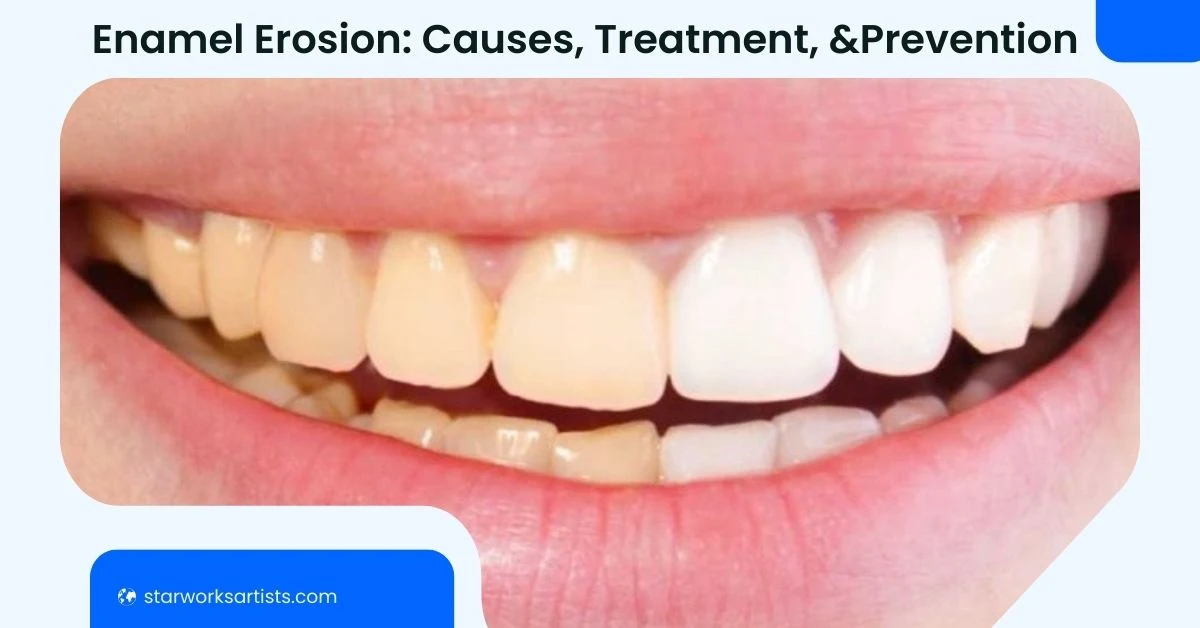Tooth enamel, the hard outer layer that protects our teeth, plays a crucial role in maintaining good oral health. However, this protective shield can be gradually eroded over time due to various factors, leading to a condition known as enamel erosion. This dental issue has become increasingly prevalent, affecting individuals of all ages and posing a significant threat to dental health.
In this article, we’ll explore the causes, symptoms, and treatment options for enamel erosion, as well as preventive measures to maintain strong and healthy tooth enamel.
What Is Enamel Erosion?

Enamel erosion is a progressive condition characterized by the gradual loss of tooth enamel due to exposure to acid from various sources. This acid can originate from dietary sources, such as acidic foods and beverages, or internal sources like stomach acid from acid reflux or frequent vomiting. As the enamel erodes, it becomes thinner and weaker, exposing the underlying dentin layer, which is softer and more sensitive to temperature changes and other stimuli.
According to the National Institutes of Health (NIH), enamel erosion is a common problem that can lead to tooth sensitivity, discoloration, and an increased risk of tooth decay and fractures. The Centers for Disease Control and Prevention (CDC) also reports that enamel erosion is a growing concern, particularly among adolescents and young adults.
Causes Of Enamel Erosion
Several factors can contribute to the development of enamel erosion, including:
1. Dietary Factors
Consuming acidic foods and beverages, such as citrus fruits, sports drinks, sodas, and vinegar-based dressings, can gradually erode tooth enamel over time. The acid in these items can soften and dissolve the enamel, making it more susceptible to wear and erosion.
2. Gastric Reflux
Chronic acid reflux or gastroesophageal reflux disease (GERD) can expose your teeth to stomach acid, which is highly acidic and can cause significant enamel erosion over time. Individuals with GERD may experience frequent regurgitation of stomach acid into the mouth, leading to prolonged exposure and increased risk of erosion.
3. Dry Mouth
Saliva plays a crucial role in neutralizing acid and remineralizing tooth enamel. Conditions that cause dry mouth, such as certain medications, radiation therapy, or Sjögren’s syndrome, can increase the risk of enamel erosion by reducing the protective effects of saliva.
4. Environmental Factors
Exposure to acidic substances in the workplace or during certain activities, such as swimming in chlorinated pools, can contribute to enamel erosion. Industrial workers, professional cleaners, and frequent swimmers may be at higher risk due to prolonged exposure to acidic or corrosive substances.
5. Eating Disorders
Frequent vomiting associated with eating disorders like bulimia can expose the teeth to stomach acid, leading to severe enamel erosion. Repeated exposure to highly acidic stomach contents can rapidly erode the enamel, leaving the teeth vulnerable to further damage.
Also Read: Swollen Gums: Causes, Treatments, And Prevention
Symptoms Of Enamel Erosion
Enamel erosion often progresses gradually, and you may not notice any symptoms initially. However, as the condition worsens, you may experience the following:
1. Tooth Sensitivity
As the enamel wears away, the underlying dentin layer becomes exposed, causing increased sensitivity to hot, cold, sweet, or acidic foods and beverages. This sensitivity can range from mild discomfort to severe pain, making it difficult to consume certain foods and beverages.
2. Discoloration
Eroded enamel can appear yellowish or dull, as the underlying dentin layer, which is more yellowish, becomes visible. This discoloration can be particularly noticeable on the front teeth, affecting the overall appearance of your smile.
3. Cracking or Chipping
Advanced enamel erosion can weaken the tooth structure, making it more susceptible to cracking or chipping. Even minor biting forces or trauma can cause portions of the weakened enamel to break away, leading to further damage and potential tooth loss.
4. Indentations or Cupping
In severe cases, you may notice indentations or cupping on the surface of your teeth, particularly on the biting surfaces of the molars. These indentations are caused by the complete loss of enamel in certain areas, exposing the softer dentin layer beneath.
If you experience any of these symptoms, it’s essential to seek professional dental care to prevent further damage and address the underlying cause of enamel erosion. Early detection and intervention can help prevent more severe complications and preserve your dental health.
How Can I Stop Enamel Erosion?
While enamel erosion cannot be reversed, there are several preventive measures you can take to slow down or stop the progression of the condition:
1. Limit Acidic Foods and Beverages
Reducing your consumption of acidic foods and beverages, such as citrus fruits, sodas, sports drinks, and vinegar-based dressings, can help minimize the exposure of your teeth to acid and reduce the risk of enamel erosion.
2. Use a Straw
When consuming acidic beverages, use a straw to minimize direct contact with your teeth. This can help reduce the amount of acid that comes into contact with your enamel, reducing the risk of erosion.
3. Rinse Your Mouth
After consuming acidic foods or beverages, rinse your mouth with water or a neutralizing solution, such as milk or a baking soda solution, to help remove any lingering acid and neutralize the pH in your mouth.
4. Maintain Good Oral Hygiene
Brushing your teeth twice a day with a soft-bristled toothbrush and fluoride toothpaste, and flossing regularly, can help remove plaque and food debris that can contribute to acid production and enamel erosion.
5. Seek Professional Dental Care
Regular dental check-ups and cleanings can help detect and address enamel erosion early on before it progresses to more severe stages. Your dentist can also provide personalized recommendations and treatments to protect your remaining enamel.
6. Manage Underlying Conditions
If you have conditions like acid reflux, dry mouth, or eating disorders, it’s crucial to work closely with your healthcare provider to manage them properly. Addressing these underlying conditions can help reduce their impact on your oral health and minimize the risk of enamel erosion.
Treatment Of Existing Enamel Erosion
If you have already experienced enamel erosion, there are several treatment options available, depending on the severity of the condition:
1. Fluoride Treatments
Your dentist may recommend professional fluoride treatments or prescription-strength fluoride toothpaste to help remineralize and strengthen the remaining enamel. Fluoride can help promote the remineralization process and protect against further erosion.
2. Dental Bonding
For minor enamel erosion, your dentist may use tooth-colored resin material to restore the affected areas and protect the underlying dentin layer. This procedure involves applying a composite resin material to the eroded tooth surface, which is then hardened with a special curing light.
3. Dental Crowns or Veneers
In cases of severe enamel erosion, where a significant portion of the tooth structure has been lost, your dentist may recommend dental crowns or veneers to cover and protect the remaining tooth structure. Crowns are custom-made caps that cover the entire visible portion of the tooth, while veneers are thin shells that are bonded to the front surface of the tooth.
4. Root Canal Treatment
If the enamel erosion has exposed the inner pulp of the tooth, a root canal treatment may be necessary to remove the infected or inflamed pulp tissue and prevent further infection. After the root canal procedure, the tooth is typically restored with a crown to protect the remaining tooth structure.
5. Tooth Extraction
In extreme cases where the enamel erosion has caused significant damage and the tooth cannot be saved, tooth extraction may be the only option. The extracted tooth can then be replaced with a dental implant, bridge, or denture to restore function and aesthetics.
It’s crucial to address enamel erosion promptly to prevent further damage and maintain good oral health. Your dentist can evaluate the severity of your condition and recommend the most appropriate treatment plan to restore your tooth structure and protect your remaining enamel.
Conclusion
Enamel erosion is a common dental issue that can lead to tooth sensitivity, discoloration, and an increased risk of tooth decay and fractures. By understanding the causes, symptoms, and preventive measures, you can take proactive steps to protect your tooth enamel and maintain a healthy, beautiful smile.
Remember to limit your consumption of acidic foods and beverages, maintain good oral hygiene, and seek professional dental care regularly. If you suspect you may have enamel erosion, don’t hesitate to consult with your dentist for proper diagnosis and treatment options.
Frequently Asked Questions
No, enamel erosion cannot be reversed.
Foods that cause enamel erosion include acidic foods and drinks like citrus fruits, sodas, sports drinks, and wine.
Vitamin D and calcium deficiencies can contribute to enamel erosion.
No, Pronamel cannot repair enamel erosion, but it can help remineralize and harden existing enamel.
It takes months for enamel to remineralize and harden after acid erosion.
References
- Johansson AK. On dental erosion and associated factors. Swedish Dental Journal. 2002;(156):1–77. [PubMed]
- Ranjitkar S, Kaidonis JA, Smales RJ. Gastroesophageal reflux disease and tooth erosion. International Journal of Dentistry. 2012 Article ID 479850. [PMC Free Article]

